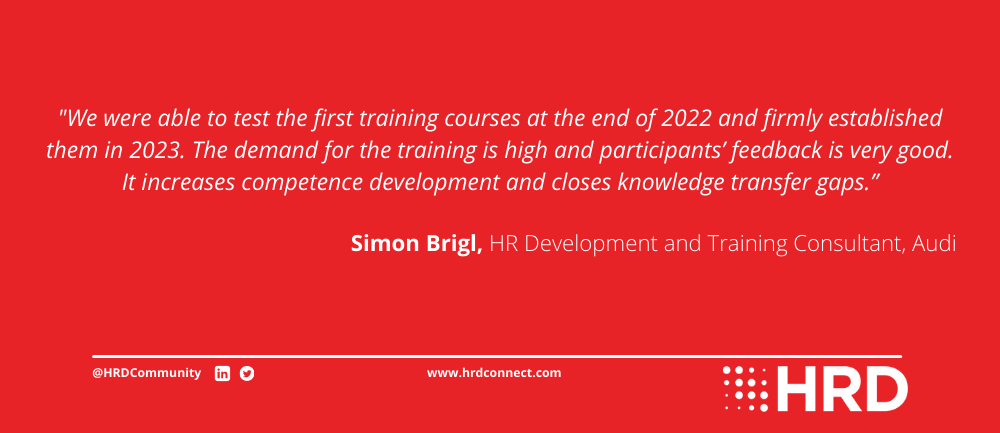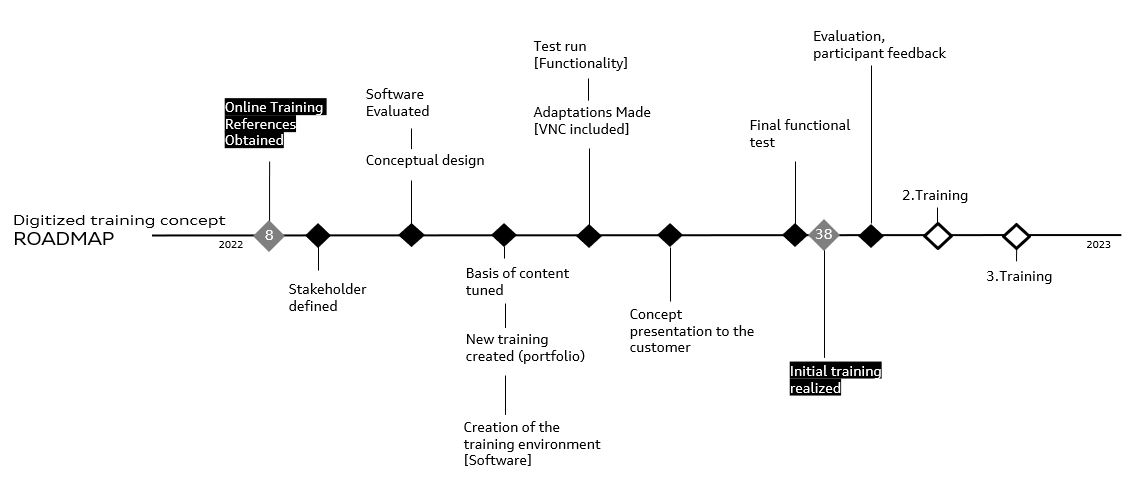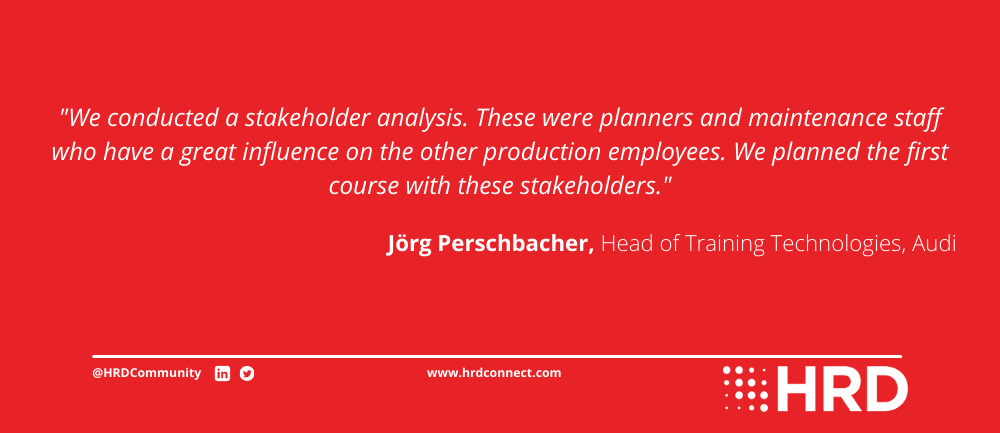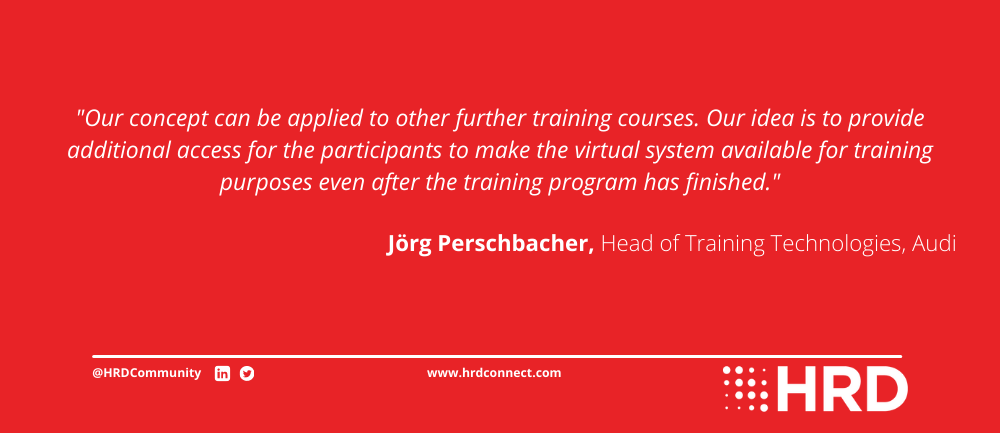-
Provided by

- Date published: Apr 17, 2023
- Categories
‘Vorsprung durch Technik.’ Audi lives up to its motto, which translates to ‘Being Ahead through Technology,’ by prioritizing sustainable personnel transformation through demography, decarbonization, and digitization. Indeed, in 2022, Audi AG invested around €150 million in its employees’ training and further education.
Audi’s Automation Technology Training team is part of the Audi Academy. This team conducts up to 900 sessions per year, working to a budget of €4.8 million. In March 2022, it embarked on a remarkable project to digitize aspects of its production line training through a fully simulated virtual environment. To date, it has trained 34 employees across six training sessions, 96% of whom had a positive experience. Moreover, software licensing fees cost less than €100 per participant, a staggering saving on the hardware components needed for in-person training that cost over €18,300.
Jörg Perschbacher, Head of Training Technologies, and Simon Brigl, HR Development and Training Consultant, take us on Audi’s digitization journey.

Hardware to software: How Audi digitized production line training
In the event of a stop in the production line due to faulty hardware, Audi’s maintenance workers must work quickly to correct errors. Before this scheme, training courses that focused on Audi’s production line were hardware-based. They could only be carried out in person. Whilst practical physical training on hardware is still necessary, the digitization of training allows those with a strong depth of hardware knowledge to adapt to rapidly changing technologies and increasingly complex vehicle systems without compromising production. “Our goal was to develop a concept that will enable us to transfer face-to-face training of automation technology into live online training,” explains Perschbacher.
Audi started the digitization process in March 2022. Initial research showed that whilst several external training courses existed, none of them met Audi’s high standards. Instead, the Automation Technology Training Team set about identifying potential software partners, and planned an in-house training program designed to address four core implementation challenges:
- Virtualizing the hardware with appropriate software
- Ensuring global access with high performance via an installed server
- Didactically selecting and designing the training topics to establish a new online format and promote the teaching of the content
- Creating a highly realistic virtual production line as a training environment
After a rigorous selection process, Audi partnered with software providers Factory I/O, Siemens, Microsoft, and RealVNC, to provide trainees with virtual hardware controls, and trainers with the technology to speak with and coach employees, regardless of location. The virtual system corresponds exactly to the physical, real-world hardware.
The Automation Technology Team also selected an external trainer as a business partner. Audi selected a specialist in the automation field who was familiar with Audi’s programming standard. The trainer worked to co-create a seamless pilot process. Brigl elaborates:
“Creating the virtual plant has been relatively easy. The software we selected allowed us to replicate our system quickly and individually.
“We were able to test the first training courses at the end of 2022 and firmly established them in 2023. The demand for the training is high and participants’ feedback is very good. It increases competence development and closes knowledge transfer gaps.”

Innovation requires iteration
Audi used repeated rehearsals to identify and iron out technical problems during the pilot stage. “If the technology failed, it would have strongly influenced acceptance and uptake of the digitized training,” Brigl admits. “We didn’t want to fail because of technology.” The team leaned heavily on the support of the external partner who contributed substantial experience in online training formats and IT skills.
After the first training, Audi further optimized the content based on feedback from participants. Perschbacher highlights where the Automation Technology Team has iterated the digitized training.
“We found the most difficult challenge during the lessons was the wide variation in the participants’ level of knowledge. We had to deal with noticeably large differences between the participants, which we had not expected to that extent. In the exercises, some participants finished much faster than others. In turn, we have installed additional tasks and obstacles for the more advanced participants.”

Driving employee buy-in
Digitization cannot succeed without employees embracing technology. The Automation Technology Training team acknowledged that employees may have reservations about embracing the digitization of this subject-specific training. “They were worried that they might be overwhelmed. We agreed to have a maximum of six participants to ensure the best possible care,” explains Brigl.
Accordingly, Audi maintained a dialog with the relevant departments throughout the coordination and planning of training courses within automation technology. This was an opportunity for the Automation Technology Training team to present plans for the digitization process in exchange for feedback. Perschbacher also emphasizes the role of identifying influential stakeholders.
“We conducted a stakeholder analysis. These were planners and maintenance staff who have a great influence on the other production employees. We planned the first course with these stakeholders.”
“We also presented the concept during technical training from other Audi Academy courses with participants from production. The idea was to win over and convince some stakeholders.”
Bringing the trainees into the creation process ensured the digitized training environment was designed to their needs and requirements, thereby securing greater buy-in from participants.
High availability, low cost: The impact of virtual training
It is crucial for Audi’s vehicle production that the assembly line has little downtime. Downtime causes significant costs. Careful training allows maintenance personnel to optimize system availability. With the technology in place, Audi delivered a completely new training course for employees at the required programming standard. The training focused on error analysis and troubleshooting. From 2022 to date, it has trained 34 employees across six training sessions. Of the 34 employees, 96% had positive opinions.
There are also eye-watering cost savings. In-person training requires components that total over €18,300. Assemblies of the hardware are very expensive and currently in short supply with long delivery times. Digitized training requires software licensing fees that are less than €100 per participant.
Moreover, when Audi’s system availability is high, it loses minimal production time. The product team is more likely to achieve daily targets for vehicle production. Creating a fully replicated virtual environment has been crucial to the success of digitizing training. Brigl offers the analogy of a pilot in training to demonstrate the need for high-quality virtual environments.
“Compare our training to a bad flight simulator. A pilot will be able to learn basic functions on this simulator. But with a poor-quality simulation, realistic flight maneuvers and behavior in emergencies are only possible to a limited extent. Real conditions are very different from badly simulated conditions. It is the same with our digital concept. “
The quality of digitization has also made it far more accessible to workers who find upskilling in IT and technology to be challenging. For such employees, a rapid and impatient rollout of a simulated training environment would prove frustrating. To avoid placing excessive demands on its workers, Audi views the digitization of its training as non-linear. “Increasingly complex systems are in use. It takes many steps and a lot of support to motivate the participants and create acceptance of digital training,” Brigl notes.
Further digitization initiatives
Digitization is a key part of Audi’s plan for sustainable personnel transformation. Alongside creating a simulated training environment, Audi has scaled a variety of impressive initiatives:
- Digital Shift: Beginning in Neckarsulm in 2021, ‘Digital Shift’ and (due to popular demand) a second scheme ‘Digital Future’ is shifting employees from the production line to digital roles including software development. Each scheme lasts six to eighteen months and includes no more than twenty participants to focus on individual support. It includes training at the Audi Academy, and practical learning, with the duration and content adapted accordingly to learning progress and competency development.
- Knowledge Networks: Audi has a cross-departmental network called #z20guides with over 300 members. Without obstacles or hierarchy, the guides show colleagues how to use new digital tools productively in their day-to-day work. Alongside bi-monthly meetups to share practical digital training and tips, the guides organize a yearly digital conference with a wide range of online sessions. In 2022 more than 27,000 people took part in the five-day event with a total of 175 learning sessions.
- Automotive Initiative 2025 (AI25): The “Automotive Initiative 2025” initiated by Audi is a world-leading competence network for digital factory transformation and innovation Suitable innovative IT solutions and upskilling initiatives come from Audi’s technology partners including Amazon Web Services and the Technical University of Munich.

The road ahead
Digitization is not achieved in a single step. With huge investments in digitization being offset by substantial cost savings, Audi is well-positioned to continue its journey to digitize its learning and development programs. Perschbacher shares a view of the journey ahead.
“In control technology, there are even more complex software solutions for the virtual representation of production plants. However, this requires a high level of computing power. For training purposes, this is currently still an obstacle, but we are already working on another pilot project.
“In addition, our concept can be applied to other further training courses. Our idea is to provide additional access for the participants to make the virtual system available for training purposes even after the training program has finished.”
Creating on-demand availability is a complete upheaval for production workers used to training in-person and with physical tools and hardware. But with best practices around buy-in, cost-optimization, and virtual training well-established, Audi is in the driving seat to achieve sustainable personnel transformation through digitization.








